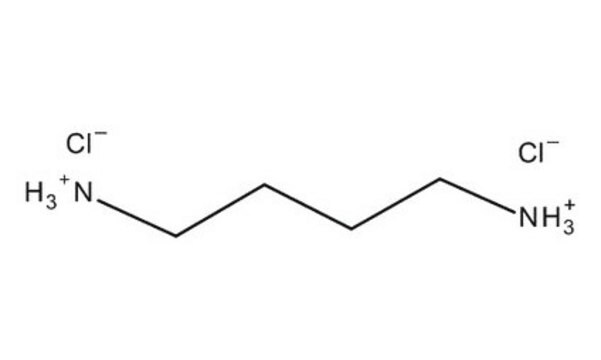P7505
Putrescine dihydrochloride
≥98% (TLC), powder
Synonym(s):
1,4-Butanediamine dihydrochloride, 1,4-Diaminobutane dihydrochloride, Tetramethylenediamine dihydrochloride
About This Item
Recommended Products
product name
Putrescine dihydrochloride, ≥98% (TLC)
Quality Level
Assay
≥98% (TLC)
form
powder
mp
280 °C (dec.) (lit.)
solubility
H2O: soluble 100 mg/mL, clear, colorless
SMILES string
Cl[H].Cl[H].NCCCCN
InChI
1S/C4H12N2.2ClH/c5-3-1-2-4-6;;/h1-6H2;2*1H
InChI key
XXWCODXIQWIHQN-UHFFFAOYSA-N
Looking for similar products? Visit Product Comparison Guide
Application
- as a bioactive amine standard in high-performance liquid chromatography (HPLC)
- as a component of hormone mix supplemented to Dulbecco′s modified eagle medium (DMEM) to study its effects on neural stem cells
- as a supplement in DMEM for culturing of endometrial cancer cells
Biochem/physiol Actions
Signal Word
Danger
Hazard Statements
Precautionary Statements
Hazard Classifications
Acute Tox. 2 Inhalation - Acute Tox. 3 Dermal - Acute Tox. 4 Oral - Eye Dam. 1 - Skin Corr. 1B
Storage Class Code
6.1A - Combustible acute toxic Cat. 1 and 2 / very toxic hazardous materials
WGK
WGK 1
Flash Point(F)
113.0 °F - closed cup
Flash Point(C)
45 °C - closed cup
Personal Protective Equipment
Certificates of Analysis (COA)
Search for Certificates of Analysis (COA) by entering the products Lot/Batch Number. Lot and Batch Numbers can be found on a product’s label following the words ‘Lot’ or ‘Batch’.
Already Own This Product?
Find documentation for the products that you have recently purchased in the Document Library.
Customers Also Viewed
Our team of scientists has experience in all areas of research including Life Science, Material Science, Chemical Synthesis, Chromatography, Analytical and many others.
Contact Technical Service











